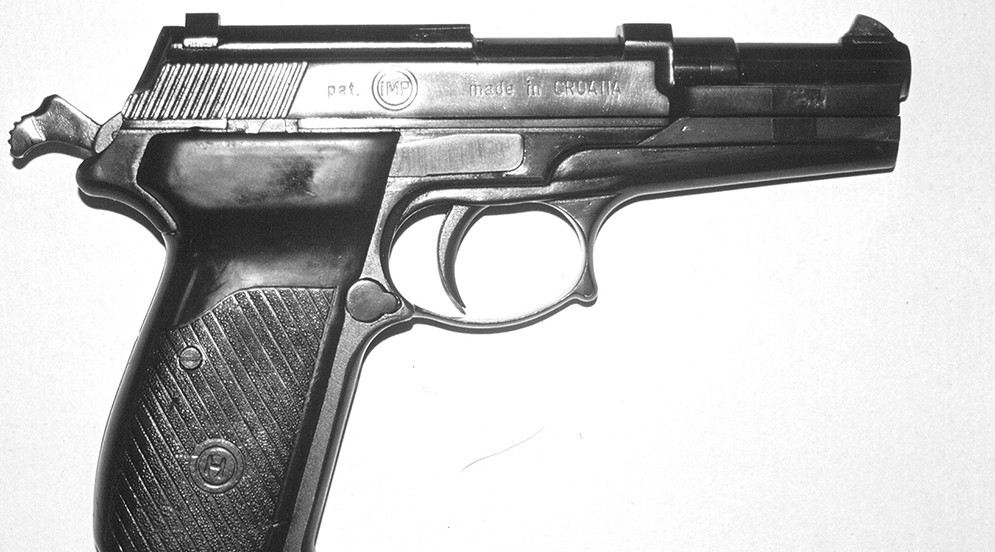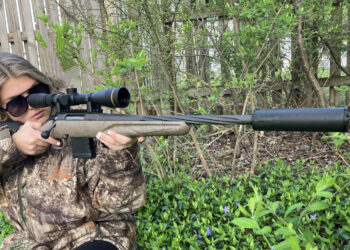The PHP was eclectic mixture between the designs of the Walther 38 and Beretta 92 pistols. Pistol was designed as a large frame, double/single action duty size handgun which utilized a locked barrel with the Walther system of falling block used also on Beretta 92 series of pistol. Other features and the appearance were similar to a Walther 38.
By Jani Kotnik
PHP
The start of Croatian handgun productions began in 1991 with first model PHP (stands for Prvi Hrvatski Pištolj – First Croatian Pistol) in 9mm Para for use in Croatian military and law enforcement forces. First model was an eclectic mixture between a Walther 38 and a Berreta 92 pistol. The pistol was designed as a large frame, double/single action duty size handgun which utilized a locked barrel with the Walther system of falling block, used also on the Beretta 92 series of pistol. Other features and the appearance were similar to a Walther 38. Open slide design combined with a straight recoiling barrel lent itself to very good accuracy, along with elimination of possible jams of ejected casings. The slide, frame and smaller operating parts were milled out of solid blocks of steel, a procedure which was later dropped in favor of more economically feasible investment casting. Magazines were a problem in the first days and were refined, with a small change in material used in the making process, and the follower was also redesigned. The magazines remain virtually unchanged and to the present day are used in all of the following models of Croatian’s pistols. In the early days of production there were 3 models of PHP pistols; standard with barrel length of 125mm (5”), compact, with shortened 100 mm (4”) barrel and slide and “target” model with extended 152 mm (6”) barrel. Out of those three, most the of production was the standard model, which saw heavy duty use during the war in Croatia in early 1991. Because of the hasty war production, parts of the PHP were prone to breaking, especially the first lots of PHP pistols which were of poor quality.
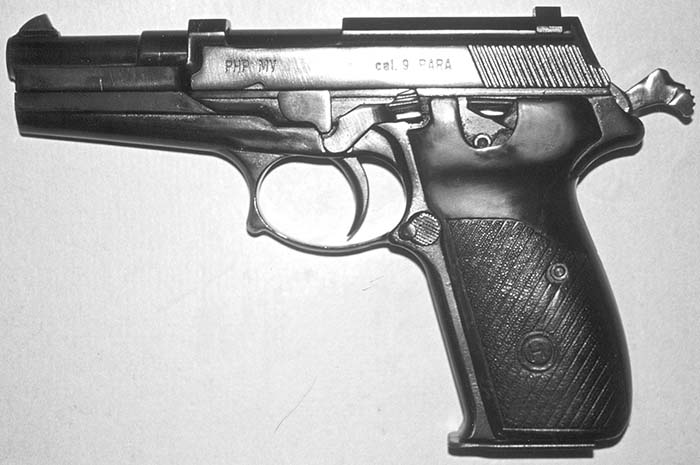
HS 95
Unsatisfactory results from field testing, and feedback from actual users were beneficial for the introduction of a new pistol in June of 1995. The new pistol was given the designation of HS (Hrvatski Samokres – Croatian Pistol): model HS 95. The HS 95 pistol, like the former model PHP, was produced in caliber 9mm PARA, ammunition that was widely adopted in various military and law enforcement units worldwide. Design was radically changed compared to the previous model. The construction was a shift from the Walther system to the modified Browning system of locking. Overall appearance of the pistol was more sleek and less chunky than former models resembling lines more popular in the SIG line, but with new technical solutions without any patent infringements. With the new model, IM Metal was utilizing a proven successful pistol design.
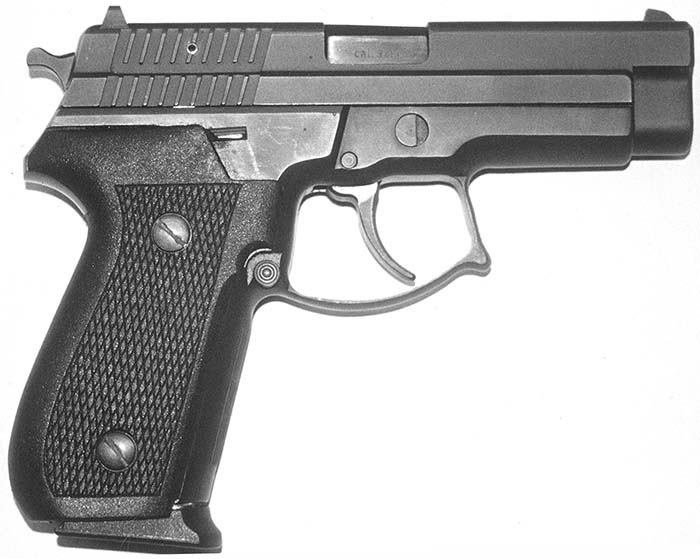
The new model was produced entirely of investment casting, which allowed for more economic production, except for barrels which were still made by classic cold hammer forging. The slide was fully closed, blocky in appearance, with a reinforced ejection port lower part as a precaution to possible material failure. This modification was later dropped out of production, as subsequent testing proved that this was more or less “overkill” in terms of slide strength.
New features included a frame mounted combination of slide release/decocking lever, automatic firing pin safety, extended trigger guard for use with heavy military style gloves, new magazine floor plates, synthetic grip panels and overall better ergonomics of the handgun. One interesting feature was employed in design: the pistol was fully ambidextrous.
The magazine release button, slide release/decocking lever were mirrored on both sides of the gun. The only “leftover” from right handed use was the disassembly lever on the left side of the frame which was designed for right handers only. Barrel to slide interface was designed around the time proven and tested modified Browning tilting barrel system with use of the rectangular rear end of the barrel mated with an appropriate cut out in the frame, which is easier to manufacture and keep tolerances on high ground. A selective double/single action trigger group combined with decocking lever and automatic firing pin safety was a very safe, yet very efficient combination as extensive testing very soon proved.
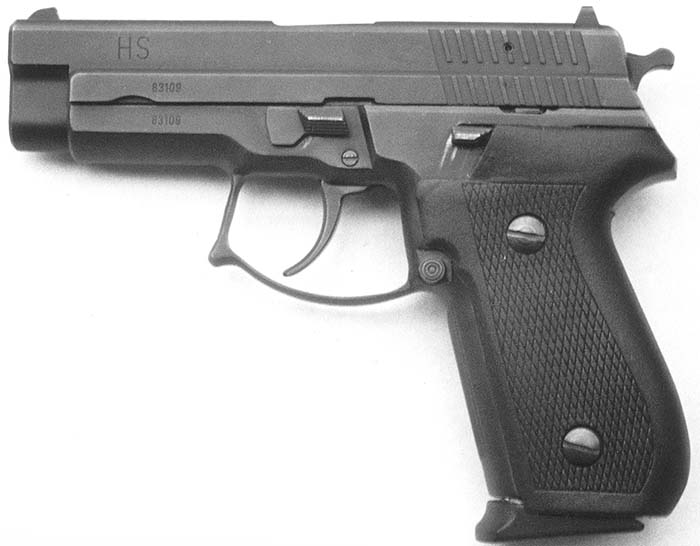
On the model HS 95, high-visibility sights in combat (bar/dot) configuration were employed. The first preserial model of HS 95 was fitted with a special adjustable rear sight, with elevation adjustment from inside of the slide, which was latter dropped in favor of a more classic dovetailed rear sight which was more than adequate for duty use. The only design change was using steel for producing an HS 95 frame. The steel frame makes the HS 95 one of the heaviest pistols of its class. Pistol HS 95, after thorough testing, found its place in several Croatian military and law enforcement units.
HS 2000
The world trend of using plastic materials for making light arms, has dictated a change in the thinking of many producers. IM Metal manufactured the first prototypes of their new “plastic” handgun in 1998. For the first time in the history of Croatian handgun manufacture, a polymer frame was employed in an effort to produce a more durable and lighter pistol. Extensive use of CAD/CAM equipment reduced the overall time needed to produce the first acceptable pistols for mass production. As we all know, it is one “thing” to have a good “paper” design, and another “Thing” to get it to functional mass production.
Plastic Frame
The new model was officially named the HS 2000 and it is produced from BASF based Ultramyd 66 material, which has an excellent chemical composition and it is thermo stable and structurally extremely durable. The first models employed all plastic slide rails, with a steel locking block in front. Front rails were later redesigned as integral part of the steel locking block, thus only the rear slide rails were left of plastic. Subsequent testing just proved the point of the designers, that the rear rails were less structurally challenged than the front counterparts. The frame is checkered in front and rear for a more positive grip even with wet or sweaty hands. The main design idea was to avoid numerous levers and buttons, simplifying it, thus making it more user friendly and easier to manufacture. The HS 2000 now has a slide release, a magazine release button and a disassembly lever, creating an easy to use foolproof design. The outward appearance of the HS 2000 is very similar to some Glock models, the frame contour is very close to the Glock model 17. However, the “interior” of the HS 2000 is very different from the Glock series of pistols.
Trigger mechanism
One very interesting feature of the model HS 2000 is the single action trigger mechanism. The SA trigger mechanism is the best feature of the HS 2000, of course that’s only my opinion. The first thing I had changed on my Walther P99 was modifying the trigger mechanism from SA/DA to SA only. The shorter and crisper trigger pull made the Walther P99 an excellent sporting pistol. The HS 2000 comes with a factory installed SA mechanism, mechanically similar to the trigger mechanism of a Mauser K98, or if you wish, a Browning model 10. The falling sear is directly engaged with the striker/firing pin so when you pull the trigger the sear slides down and disengages the firing pin. Additional safety to the SA trigger mechanism is provided with the grip safety (Colt 1911 type), if you do not grip the pistol firmly, the trigger mechanism is not in the activated position, and renders whole pistol virtually useless. The beaver-tail safety blocks slide movement and effectively blocks the sear to avoid accidental discharge in the event of dropping it. Combined with an automatic firing pin safety which effectively blocks the firing pin/striker until the trigger is fully depressed, it makes the pistol safe. This pistol is considered safe to carry with a loaded chamber, but carry the pistol with an empty chamber to avoid unintentional discharge, in normal code “white” situation.
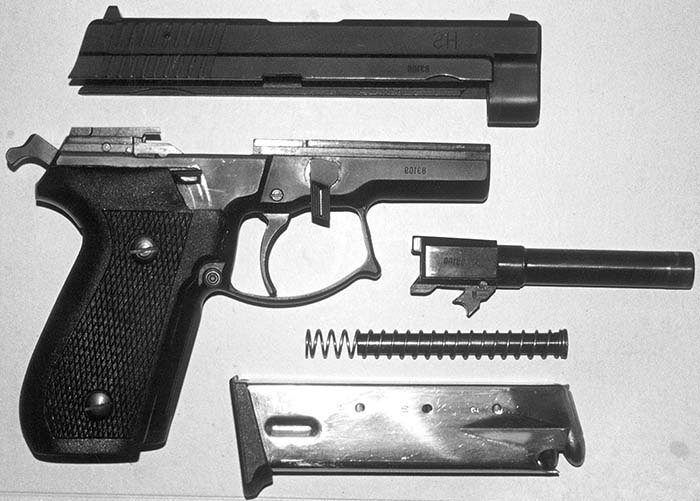
The HS 2000 had a trigger pull of only 1.5 kp, which was increased to 2.0kp at the request of users. The SA trigger mechanism allows factory adjustments from 1.5 kp through 6.0 kp while still remaining fully operational and safe. Competition models are factory produced with tuned triggers with shortened trigger travel and a pull weight of only 1.2 kp, but comes with a disclaimer that these models are NOT FOR DUTY use. Use of a newly designed trigger and frame allowed for very short trigger reach that was comfortable for people with smaller hands, but still remains ergonomical even for people with larger hands. The firing pin protrudes to the rear of the slide, where it is readily visible and felt, so you can check the state of the trigger mechanism.
Magazines
The HS 2000 shares the same magazines with its predecessors. The magazines are made from stainless steel. For most markets their capacity is 15 rounds, except for US/Canadian market where they are limited to 10 rounds only. The rear of the magazine has witness holes for a visual check of magazine status, labeled “5”, “10” and “15”. Magazine floorplates are made from the same polymer as the frame, eliminating possibility of breakage in speed reloads.
Slide/barrel
As in the older model HS 95, the slide of the HS 2000 is entirely made out of investment casting, thus reducing machining operations and reducing cost of manufacture. The design employed a two-step layout in order to reduce overall weight of moving parts, while maintaining the structural integrity of the slide itself. The slide houses the integral shielded extractor (Browning HP type), striker/firing pin assembly and automatic firing pin safety. The front portion of the slide is intentionally made thicker to avoid any possible structural problems on the most stressed point, where the recoil spring mates with the slide. The first models featured a front sight integral with the slide, but for the sake of compatibility with aftermarket sights and ease of replacement this was changed to a more conventional dovetail model. The rear sight is drift adjustable and comes standard as a bar/dot configuration with front sight, or upon request it is possible to get 3-dot configuration or night sights as option. The widened and lowered ejection port eliminates the event of stovepipe jams or failure to completely eject empty casings. As the system used for locking is a modified Browning tilting barrel system, the ejection port serves as part of the locking mechanism, since rear square portion of barrel mates with the appropriate cutout of the ejection port on the slide.
Barrels are made of premium bar stock that come raw from the Austrian barrel manufacturer, Bohler. Bohler has years of experience of barrel making, and some of the finest European custom rifles are built with their barrels. Barrels come in raw 2 inch bars, already hammer forged and rifled, which are then machined into the final contour of the HS 2000 barrel. For ease of manufacture barrels are a two piece assembly, consisting of the barrel itself and a rear reinforced “head “of the barrel. After the production of both parts they are joined “in hot” and extra secured by a lower pin “just in case”.
Before final assembly into pistols, all barrels must pass additional proof testing in a machine rest where pressure, accuracy and consistency are tested. The final step is to fit actual barrels to slides and frames, but thanks to modular design and high tolerances held, little to no fitting is required in this final step.
The recoil spring assembly consists of dual telescoping springs (Glock 26 type), which are used in order to lessen recoil sense and also reduce hammering of frame during firing.
Easy to shoot with HS 2000
In field stripping the HS 2000 you should inspect the chamber and ensure that the pistol is not loaded. Remove magazine, lock slide in rear position, rotate disassembly lever upwards -clockwise 90 degrees. While gripping the slide, press the slide stop and released the slide. To slide the slide from frame you should pull trigger and slide will come off. Remove recoil spring and barrel. For assembly just reassemble parts in reverse order.
There is only a disassembly lever, slide release and ambidextrous magazine release button to fuss with during normal operation. The HS 2000 offers the shooter relatively soft recoil, if you are using the standard 9mm ammo. It is easy to shoot, and quick double shots can be achieved by the inexperienced shooter. On the 25 mm target I have off-hand shot 10 cm groups with S&B ammo. On the FBI target in fast drill exercise I have put all the bullets in the center of the “ bad guy” in very short time. The 250 S&B rounds were fired in a test of the new HS 2000, pistol function was flawless. The HS 2000 passed the short test with flying colors, but the extended field use will show the quality of the new Croatian pistol. The Induchem d.o.o. company from Zagreb offered all three of the Croatian service pistols; PHP, HS 95 and HS 2000 as a collection.
Because of the war the Croatian IM METAL pistols production evolved in a very short time from a small garage-type of production into a respectable pistol maker. Time will show how well they will succeed in a peace time international market.
| This article first appeared in Small Arms Review V4N8 (May 2001) |



